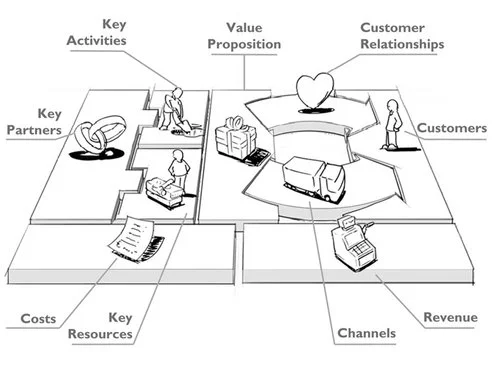Say What?
We often discuss Business and Operating Models in our consulting and training engagements. These terms are frequently the source of unnecessary confusion, with people not being clear if they are synonymous or distinct concepts, or how they are inter-related. Our view, broadly supported by literature and leading practice, is that business models define how organizations will deliver value to customers in their target market segments in a sustainable manner, while operating models define the underlying arrangement of people, processes, systems and information needed to execute the business model.
Osterwalder and Pigneur (2010) did a fine job to define a Business Model through their development of the Business Model Canvas framework in their book titled "Business Model Generation". Their succinct canvas-styled model has become popular amongst those involved in business strategy and innovation, where it serves as an excellent tool for brainstorming, developing different patterns, what-if analyses and the like.
Hit and miss…
However, from the perspective of Business and Enterprise Architects, as key role players responsible for ensuring alignment between business strategy and IT capability, it seems that even with a well-defined strategic direction, the strategy execution process often still goes awry. It remains challenging for Operations and IT to determine how they need to respond to and act upon the chosen strategic direction, whether it is based on Customer Intimacy, Product Leadership or Operational Efficiency.
Just get the basics right
We believe that this is where the fundamentals of Operating Model design, as defined by Ross, Weill and Robertson (see: "Enterprise Architecture as Strategy" (2006)), come into play. They call for designing and building a foundation of processes and systems - the essence of an operating model - by interpreting the chosen strategic direction in terms of the appropriate level of process and systems standardization and integration. Based on this insight and well informed, "overt" standardization/ integration decisions, organizations are able to specify the key architectural requirements and subsequently design and build foundational processes and systems, layer by layer. Using an approach akin to Gartner's pace layering model, the initial focus needs to be on routine business activities, digitizing these to a level where it becomes a stable and predictable platform. Achievement of stability at the foundational layer frees the resources to extend the foundation to the next layer (and then the next layer) of processes and systems, which enable differentiation and innovation.
By using this approach, Operations and Systems team may still not be able to anticipate business changes, but they can increase the likelihood that the needed processes and information are either readily available, or can easily be provided. Inspired’s business architecture approach integrates these and other strategy techniques to accomplish this seamlessly.
References:
Gartner (2012). Accelerating Innovation by Adopting a Pace-Layered Application Strategy (available at: https://www.gartner.com/doc/1890915/accelerating-innovation-adopting-pacelayered-application)
Ismail, S., Malone M.S. and Van Geest, Y. (2014). Exponential Organizations: Why new organizations are ten times better, faster and cheaper than yours (and what to do about it). Published by Diversion Books.
Kim, W.C. and Mauborgne, R. (2015). Blue Ocean Strategy: How to Create Uncontested Market Space and Make the Competition Irrelevant. Published by Harvard Business School Publishing Corporation.
Osterwalder, A. and Pigneur, Y. (2010). Business Model Generation. Published by John Wiley & Sons.
Ross J.W., Weill, P. and Robertson, D.C. (2006). Enterprise Architecture as Strategy. Published by Harvard Business School Press.



